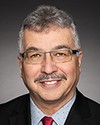Thank you, Mr Chair.
Thank you to the committee and to the staff, as well as my colleagues here today. It was most interesting listening to the passion of everybody.
NATA represents northern remote operations across Canada in these important pre-budget discussions. We previously submitted a briefing note to the committee with NATA's 2017 resolutions, identifying infrastructure issues, funding issues, as well as funding solutions. We have also identified regulatory issues that would increase the cost of federally funded programs, such as health programs and sovereignty support flights.
The Northern Air Transport Association was formed just over 40 years ago with a mandate to help in the economic development of northern Canada by providing safe, reliable, and sustainable air transport support. NATA membership is representative of all aspects of northern remote air operations, including scheduled passenger and cargo service, air taxi operations, helicopters, and specialized operations, including internationally renowned medevac capabilities.
For today, Mr. Chair, NATA was asked to provide input on two specific questions, and we welcome this opportunity.
In regard to what federal measures would help Canadians be more productive, I polled my directors overnight and received several responses that focused on the need for a well-trained workforce and indeed a strategy to attract a replacement workforce. NATA's chair of its skills development committee offered the following quote:
The most critical thing is training. I believe that training for the commercial licence and above, i.e. Multi engine rating and Instrument flying rating have tax rebates for the student. Maybe it is time to bring back the incentive on top of the rebate, as there was back in the 1950’s and 60’s whereby students who completed their training also received a ‘bonus’ from the government. In the day it was to have a base of pilots ready to join the RCAF if necessary, but I think that it could be an idea to help defray the huge costs to the candidate, before they can even start applying for a job.
In 1970, when I obtained my private licence, I got $100 back from the federal government, which I used towards the night rating. My private licence cost me $990. Up until 1990, private pilot training was tax exempt through the Excise Tax Act, but this exemption was removed because it was considered a recreational activity. By the way, a PPL, private pilot licence, today costs about $9,000, and there are no enrolment or graduation benefits. This has resulted in a reduction of student starts, which also means fewer pilots progressing to commercial pilot training. This has led to a skilled labour shortage in Canada that extends to flight crew as well as maintainers. There is a simple solution to this problem: reinstate a tuition tax exemption and a graduation rebate upon completion of commercial pilot training.
There needs to be a better program that provides employers with incentives to hire graduates and provide a comprehensive training program. For instance, in 1982, back when I had hair and was a lot taller, there was a pilot shortage. Canada Manpower at the time provided funding to upgrade my flight crews with multi-engine and instrument flying training.
The industry has developed some very innovative programs such as Air Inuit's Sparrow program to attract northern youth, which has resulted in the successful development of over a dozen Inuit flight crews. There needs to be more skills development funding opportunities that are aviation-focused with aboriginal and northern outreach for the future workforce.
In closing off on question number one, I think the following comment from one of my other board members is important: “I think it is important that the federal government understand the critical nature of the pending pilot shortage.” We are now parking airplanes in Canada. “This shortage will impact all Canadians as air transport has become a critical aspect”, a norm to life, “to all Canadians.”
The federal job grant is capped at $10,000. We think there's a good opportunity to increase that to help employers get the biomass of the workforce back.
This ties to the second question, Mr. Chair. What federal measures would help Canadian businesses to be more productive and competitive?
NATA's response is the lack of airport infrastructure. According to the Office of the Auditor General's report on Transport Canada's northern infrastructure strategy “Civil Aviation Infrastructure in the North—Transport Canada ”, only about half of the 117 airports listed have adequate navigational runway lighting and length compared to southern Canadian airports. Only 10 have hard-surface runways. I'll come back to that in a minute regarding innovation. This causes aviation safety issues as well as service delivery issues, which can also impact society system safety overall. For example, if an air operator cannot get in or out of an airport while trying to deliver an essential service, such as a medevac, this causes undue stress on the whole system, including the air operator, the health providers, and the family.
What recently happened just last week in Rankin Inlet, Nunavut, is a good example of the need for better northern infrastructure support, both in runway construction and passenger support. We also provided a solution in our submission of the use of the airport rent. A flight scheduled from Rankin Inlet to Arviat was unable to depart due to inclement weather in Arviat. It happened on September 19, and stranded 15 passengers. By the time the passengers deplaned and boarded a smaller craft, because the 737s used to fly out of Winnipeg to Rankin Inlet are not able to land on Arviat's short gravel landing strip, the weather made landing impossible.
The operator started to make phone calls and realized that the hotels—all three of them—were booked up, adding that the airline would have paid for the hotel rooms had they been available. Blankets and pillows were distributed to make people as comfortable as possible for the night given the circumstances, and staff came in at about 5:00 a.m. to give passengers taxi vouchers and meal vouchers so that they could get into town and have breakfast. They got them into Arviat that morning.
It was good work by the air operator. However, as was published in the report of the Canada Transportation Act review, the predominant material used in airstrips in the territories is compacted gravel. The only jet aircrafts in service that can use these airstrips are Boeing 737-200s—the latest 737s are 900s—which are between 25 and 45 years old and are no longer manufactured. There are no new 737s that can land on gravel.
Most northern airports are not capable of accommodating jet aircrafts. This requires the use of aircrafts that are smaller and have less payload capability, which in turn contributes to the higher cost of living in remote communities.
The federal government needs to implement a new northern and remote airport infrastructure investment program to deal with the airport infrastructure deficits in the territories and in remote airports in the provincial north. Like ACAP, this program would include airport infrastructure improvements such as paving, not just maintenance.
NATA supports this recommendation, with the caveat that flexibility is needed in the application of current standards such as the “Aerodromes Standards and Recommended Practices (TP 312) 5th Edition”, which requires that all airports meet the standard before any funding is given. However, half the airports were built so long ago that we can't move the facilities, so they can't get access to funding. It seems like a nasty catch-22.
In closing, and I have to give thanks again to Mr. McLeod, on August 27, 2017, in Yellowknife, Minister Marc Garneau announced the national trade corridors fund, with a request that expressions of interest be submitted by September 5.
NATA submitted an expression of interest to this fund, which we hope will provide support for a test project of runway surfaces that have a performance rating equivalent to that of asphalt, with fewer of the the negative operational aspects associated with building paved runways in northern and remote locations. These negative aspects, such as locating the paving equipment on site, and the ongoing maintenance, now include the real climatic changes that are impacting the permafrost, which doesn't help because runways are black and therefore attract more sunlight. It's an ongoing problem.
In closing, NATA encourages the finance committee to meet with northern stakeholders with a more formal regular forum to address the aviation transportation needs of northern and remote communities. We would be prepared to provide a comprehensive brief to the committee if it is helpful in recognizing the northern operational realities and funding priorities.
Thank you very much.










